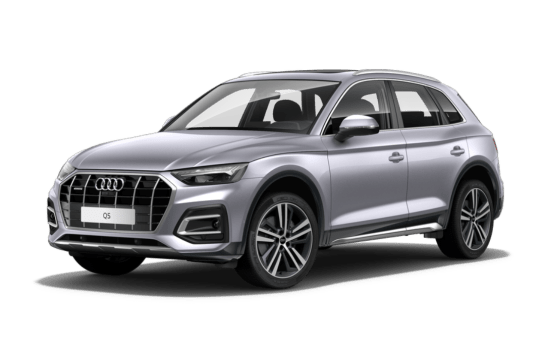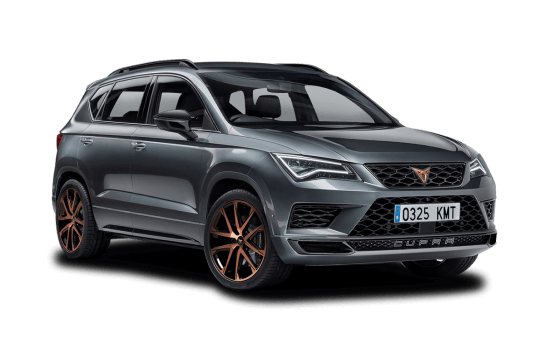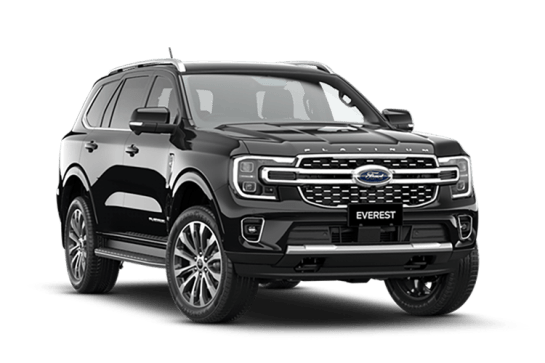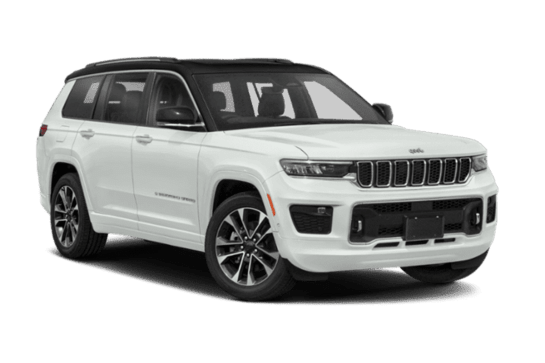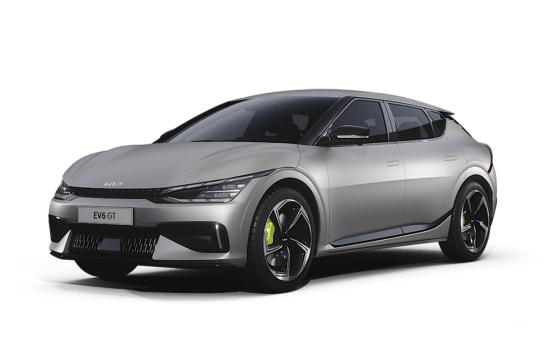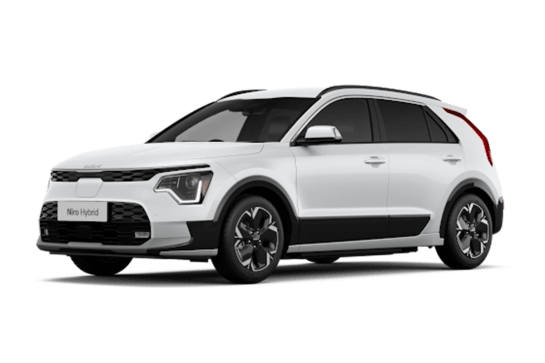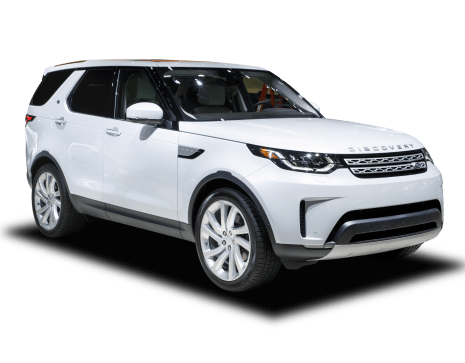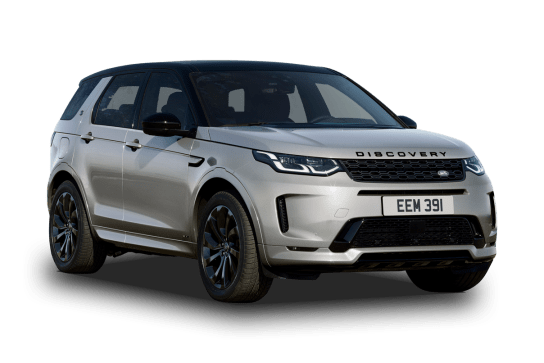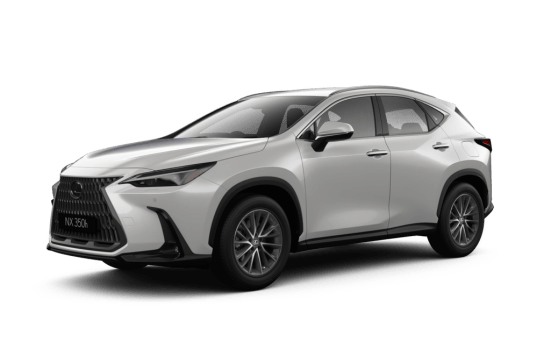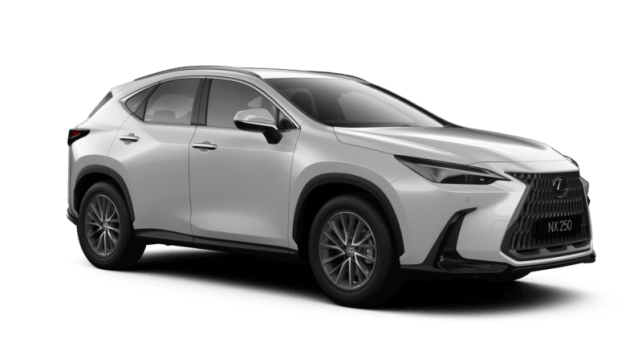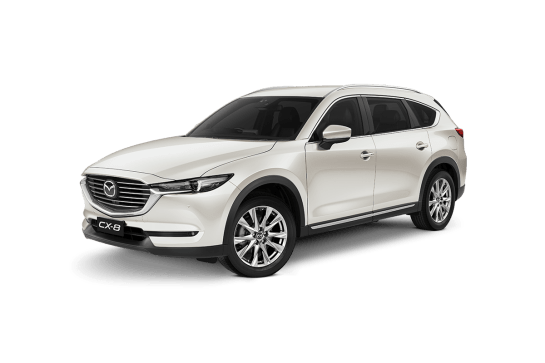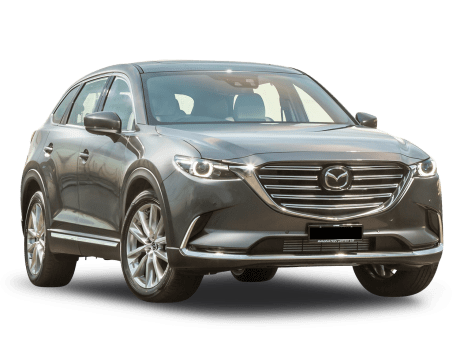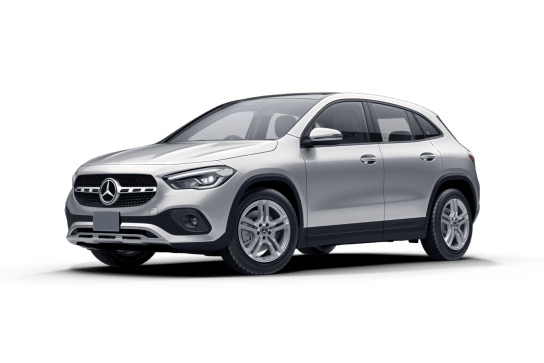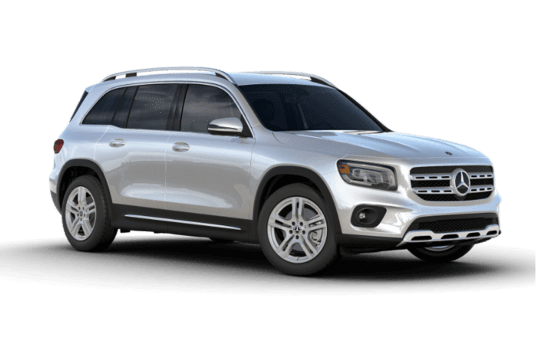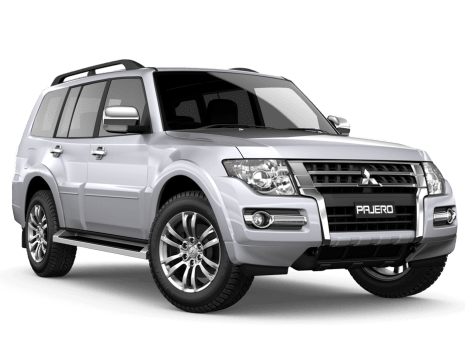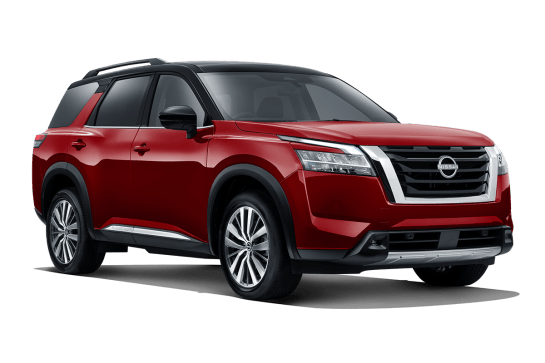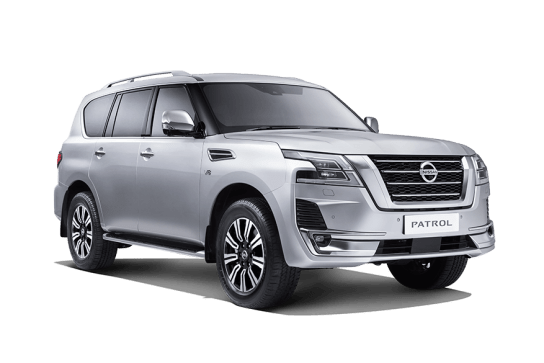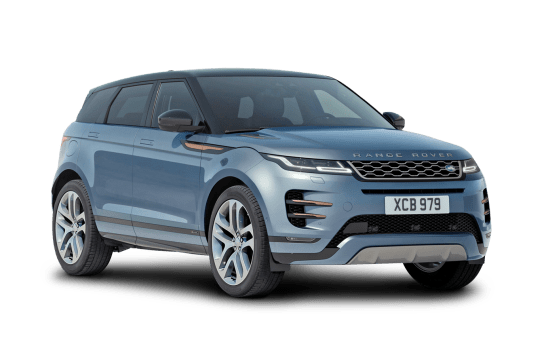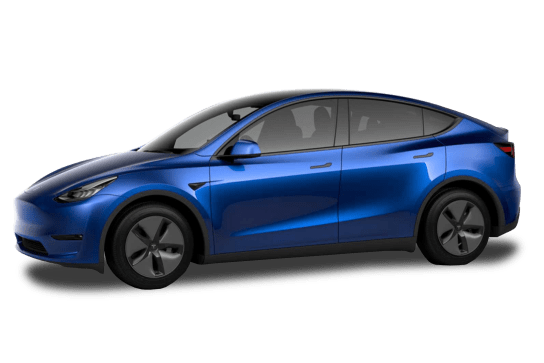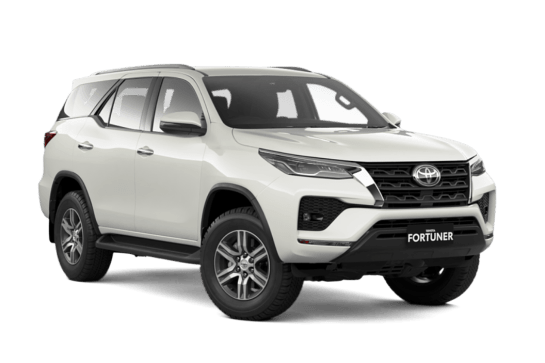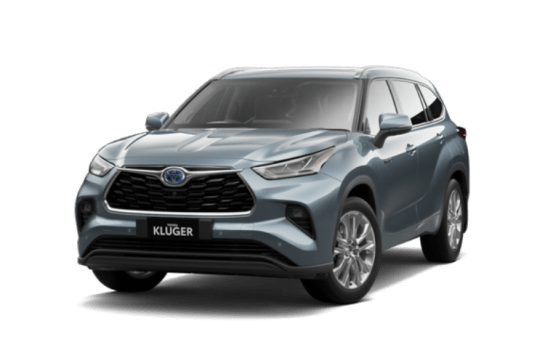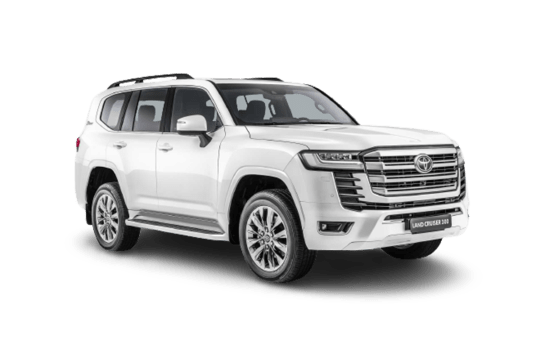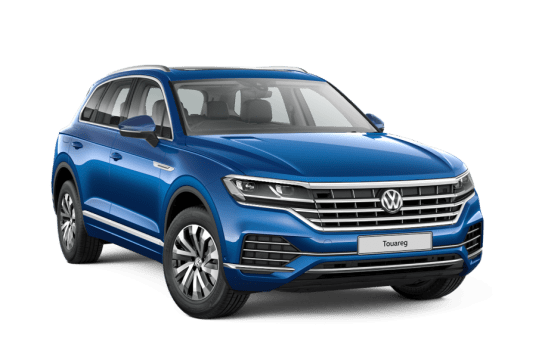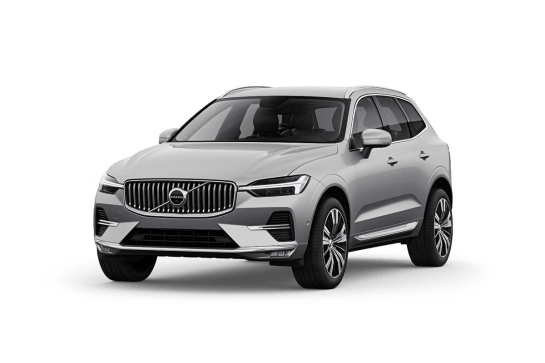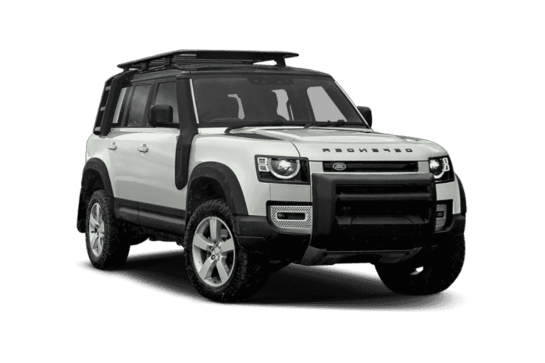
Land Rover Defender VS Nissan Patrol
Land Rover Defender
Likes
- Great to drive
- Very practical
- Very comfortable
Dislikes
- Auto shifter is fiddly
- Less-than-ideal fuel consumption
- 3000kg towing capacity is below segment standard
Nissan Patrol
Likes
- Big V8
- Very comfortable on-road
- Very capable off-road
Dislikes
- Price jump
- Bit thirsty
- No ANCAP safety rating
Summary
Land Rover Defender
The Land Rover Defender 130 is the big dog of the Defender line-up. It’s bulky and long, roomy inside (with three rows of seats) and offers plenty in terms of onboard features and optional extras.
The latest generation has managed to retain the old beloved Landie spirit and combine it with contemporary styling.
But that’s not worth noting. What is worth noting right at the get-go is the fact that the last of the V8s on offer in the range – the 5.0-litre supercharged V8 pumping out 368kW/610Nm – is in our test vehicle, the Land Rover Defender 130 P500.
Read more about
- Land Rover Defender V8 beats Ineos Grenadier to the punch... for $370,000! Works Bespoke program restoring Defenders with modern features and extensive customisation
- Watch out Toyota LandCruiser 300 and Ford Ranger Raptor: Land Rover Defender muscles up to leave tough 4WDs such as the Toyota Prado 250, Nissan Patrol and GWM Tank 500 in its dust
- Ineos Grenadier 2024 review
Also worth noting, the V8 has the option of 'Captain Chairs'. This second-row seating choice comprises two individual seats, with winged headrests and arm rests, separated by an aisle for walk-through access to the third row.
So, while the short-wheelbase Defender 90 is likely the best choice for the more adventurous off-roaders among us, is the Defender 130, as large and in charge as it is, the better choice for a family?
Read on.
| Safety rating | — |
|---|---|
| Engine Type | 5.0L |
| Fuel Type | — |
| Fuel Efficiency | 12.7L/100km |
| Seating | 8 seats |
Nissan Patrol
The Nissan Patrol has copped flak in recent years because it hasn’t kept pace with its rivals in terms of modernity, specifically its in-cabin look, design and multimedia systems.
The new Y63 Nissan Patrol is due to go on sale in Australia before the end of 2025, but in the meantime, Nissan has upgraded the current-generation Patrol in an attempt to address those issues.
The Patrol range now has, among other things, an upgraded multimedia system with a larger 10.1-inch touchscreen, a 15W wireless smartphone charge pocket, Hema off-road mapping and it finally has Apple CarPlay and Android Auto.
Read more about
- How this car brand has turned itself around: Nissan bounces back on the resurgence of X-Trail e-Power hybrid as an alternative to the Kia Sportage and Toyota RAV4 Hybrid
- How long will this electric car pioneer be without an EV? No more Nissan Leaf production and Ariya hold-up may see Japanese brand without a rival for Tesla Model Y or MG4 in Australia for a while
- Why the Nissan Patrol Warrior didn't become a $200,000 V8 supercharged off-road weapon and instead focused on value to challenge the LandCruiser 300 Series GR Sport
There was a lot to like about the Patrol before this upgrade. Depending on the variant, you get seven or eight seats, a stack of standard features and this 4WD is a proven touring and towing platform. But has this latest range refresh given the Patrol even more appeal?
Read on.
| Safety rating | — |
|---|---|
| Engine Type | 5.6L |
| Fuel Type | — |
| Fuel Efficiency | 14.4L/100km |
| Seating | 7 seats |
Verdict
Land Rover Defender7.6/10
The Land Rover Defender 130 P500 V8 is big, roomy and great to drive. It’s supremely plush without sacrificing practicality and if you’re in the market for a spacious, comfortable and refined package and aren’t afraid to open your wallet, then this long Landie is well worth your consideration.
Do you need the V8? Of course you don’t – and the diesel variants make a lot more sense anyway in terms of day-to-day fuel efficiency – but, geez, it's a lot of fun to drive.
Nissan Patrol7.6/10
The Nissan Patrol is nice to drive on-road for a big 4WD wagon – it’s refined, it’s comfortable – and it’s a very capable 4WD.
This is a proven touring and towing platform – and the upgraded multimedia system brings the Patrol up to date and adds a much-needed tech boost to the package.
There’s a lot to like about the V8 and though the Patrol’s interior still feels old, if you can’t wait for the next-gen Patrol this upgraded version might be just right for you.
At this price, though, the Premcar-enhanced Warrior is the better bet.
Design
Land Rover Defender
The Defender 130 measures 1970mm high, 5358mm long (including rear-mounted spare wheel; 5099mm without), and 2105mm wide (with the wing mirrors out). It has a 3022mm wheelbase and a listed kerb weight of 2745kg (unladen).
It is big, but really it’s no more intimidating to drive than a Toyota LandCruiser 300 Series or Nissan Patrol.
Upper large SUVs have a Federal Chamber of Automotive Industries-defined footprint bigger than 9801mm – think 300 Series LandCruiser (close to 5.0m long), Hyundai Palisade (almost 5.0m long) and Nissan Patrol (almost 5.2m long).
In terms of styling, the 130 strikes an effective balance between the distinctive shape and spirit of the old-school Defender with the new-generation’s pomp and presence – and the striking Carpathian Grey paint on this variant complements that blend.
The current-generation Defender is no city-soft shadow of its former adventure-tackling self that Landie lovers everywhere feared it might be. But it’s modern and sleek enough to put the minds of urban dwellers/weekend warriors at ease.
Nissan Patrol
The Nissan Patrol is 5175mm long (with a 3075mm wheelbase), 1995mm wide, 1955mm high and it has a kerb weight of 2861kg.
This bulky wagon takes up plenty of real estate and looks as impressive as you’d imagine rolling thunder to look on the road.
Though the range upgrades have mostly been limited to the multimedia system, that’s fine because – until the new Patrol arrives – the current Patrol has more than enough presence at rest and on the move to catch the eye, and not simply because of its sheer bulk.
Whereas the 300 Series has become a bit softer around the edges and, gulp, more contemporary, this generation Patrol at least retains some of the heavy-shouldered stature of 4WDs past.
Its interior, though slightly different to that of pre-upgrade versions, remains comfortably familiar, and I like it.
But even with new the tech offerings and the introduction of a few concessions to our charge-hungry generation, the Patrol’s cabin still feels old. I don’t mind it, but I’m sure there are some people who reckon the next generation can’t arrive soon enough.
Practicality
Land Rover Defender
The Defender 130 is well-suited to people-carrying duties thanks to its three-row seating.
And don’t forget this test vehicle has (optional) Captain Chairs in the second row.
The cabin has a distinctive premium look and feel about it, without sacrificing anything in terms of just how practical it all is. It’s a pleasant mix of durable materials – carpet mats and soft-touch surfaces – and stylish touches, such as a metal Defender-stamped section in front of the front passenger.
Layout is user-friendly and this is an easy cabin in which to swiftly become comfortable as all controls easy to locate and operate even when busy negotiating with your teenagers who gets what song next.
Storage spaces include a deep centre console, glove box, twin cupholders between driver and passenger, sunglass storage, door pockets and shallow spaces positioned about the cabin for your everyday carry gear.
Charge points include USB-Cs up front and a wireless device charging tray.
The driver and front passenger get ample room and plenty of amenities and those behind them also fare well with adequate room for everyone – even those in the third row.
All seats are comfortable and the front seats are 14-way power-adjustable with heating, cooling and memory.
The second row – two outboard Captain Chairs in this test vehicle – have a headrest and armrests for both passengers.
The third-row seats are heated and configured in a 40/20/40 pattern.
The rear cargo area is small in this seven-seater, although it offers a listed 389 litres with all three rows up and in use. That area has a sliding cover (which conceals your valuables from the prying eyes of nefarious types), cargo-restraint points, power sockets and a shallow underfloor storage space.
With the third row folded down, there is a listed 1232 litres of space. The maximum loadspace volume behind the front row is a listed 2231 litres.
There is a lot more to admire inside this Defender’s cabin for those who love the interiors of plush SUVs, but rather than spending my time stroking leather accents, going ‘ohhhh-ahhhh’ over a sunroof or reflecting on the butt-warming benefits of a heated seat, I like to actually drive.
So I did. A lot.
Nissan Patrol
The Patrol cabin is plush and comfortable, a nice blend of premium and practical.
Up front, it’s a well-appointed space – leather everywhere, as well as soft-touch, padded and durable surfaces – and the fit and finish is impressive.
You get a 10.1-inch touchscreen multimedia system (with wired and wireless Apple CarPlay and Android Auto), digital radio, steering-wheel-mounted everything and the front seats are power-adjustable (10-way for the driver, eight-way for the passenger).
There are plenty of storage spaces up front – including a deep centre console that can be used as a cooler box, little nooks for your wallet/keys/etc, as well as pop-out cupholders and door pockets. As well as enough USB points (USB-C, USB-A and a wireless charge pocket) to keep your devices powered up.
There are four 12V outlets (front, centre console, second row and rear luggage area).
The second row is very comfortable; when I sat behind my driving position I had head, shoulders and leg room. The second-row seats are a 60/40 split-fold configuration, with manual recline and fold function and a fold-down centre armrest.
For baby capsules or child seats, the two outer seats in the second row include a top tether point and ISOFIX anchors.
There are cupholders in the fold-down armrest as well as controls for the air con and two USB ports on the back of the centre console.
The third row is a 60/40 split-fold configuration with manual recline and fold function. There is one top tether anchorage point.
In terms of third-row seating comfort, it’s okay. There’s room enough for a Hobbit like myself, but the seats are flat and unsupportive.
All three rows get air con – there are roof-mounted vents – and there are a few handy storage spaces in the third row, but no cupholders.
With the third-row seats in use boot space is listed as 467L. With the third row stowed away, there’s a claimed 1413L of cargo space. With the second and third rows stowed, there’s a claimed 2623L, which is plenty.
Price and features
Land Rover Defender
The 2025 Land Rover Defender 130 P500 V8 has a manufacturer’s suggested retail price of $216,197 (excluding on-road costs). But because our test vehicle has a raft of options onboard – matte protective film ($6840), 'Carpathian' exterior pack ($2400), second row heated and cooled a pair of Captain Chairs with winged headrests as the second row ($1930), Carpathian grey premium metallic paint ($1040), and a rubber load space mat ($320) – it has a price as tested of $228,727 (excluding on-road costs).
The Land Rover Defender 130 P500 V8's standard features include an 11.4-inch multimedia touchscreen (with Apple CarPlay and Android Auto), wireless device charging, a head-up display, interactive driver display, as well as 22-inch satin dark grey wheels, quad outboard-mounted exhaust pipes, 'Terrain Response 2' with 'Dynamic Program', privacy glass, a heated steering wheel and an electrically-adjustable steering column.
Also included are bright metal pedals, configurable cabin lighting, a load space cover, satin chrome gearshift paddles, illuminated metal tread plates (with V8 branding), four-zone climate control, 'Ebony Windsor' leather and Kvadrat (wool blend textile) seats, Meridian audio, 'Online Pack' (with data plan), a head-up display, a 12V power socket in the boot and the 'Pivi Pro' multimedia system.
Paint choices on the Land Rover Defender 130 P500 V8 include 'Fuji White' (solid) or 'Santorini Black' (metallic with body-coloured roof) – or you can opt for 'Carpathian Grey' (premium metallic with black contrast roof), which is a $1040 option (price correct time of writing).
This Defender is available with the 'Extended Black Exterior Pack' ($1707) or the 'Carpathian Exterior Pack' ($2396).
Nissan Patrol
The Ti-L has a manufacturer suggested retail price (MSRP) of $101,600, excluding on-road costs.
One of its chief rivals, the Toyota LandCruiser 300 Series Sahara, has a price-tag of approx. $138,191, before on-road costs, so right there is a saving of almost $40,000.
The new price-tag means buyers are forking out $3000 more for the new gear over a standard non-upgraded Patrol.
Standard features now include the new 10.1-inch touchscreen multimedia system (with wired and wireless Apple CarPlay and Android Auto), digital radio, built-in navigation, a 15W wireless smartphone charge slot, as well as three-zone climate-control, front and rear parking sensors and a power-operated tailgate.
It also has 10-way driver seat with power slide/recline/height/tilt/lumbar adjustment, driver’s seat memory (with two settings, including side mirrors and steering column), eight-way front passenger seat (with power slide/recline/height adjustment) and heated/cooled front seats.
Again, compared with Toyota LandCruiser 300 Series Sahara, the Patrol offers just as much onboard gear for considerably less money.
Exterior paint choices on the Ti-L include the no-extra-cost 'Gun Metallic' or premium paint jobs: 'Brilliant Silver', 'Black Obsidian', 'Champagne Quartz', 'Hermosa Blue' and 'Moonstone White'.
Under the bonnet
Land Rover Defender
The Land Rover Defender 130 P500 V8 has a 5.0-litre supercharged V8 petrol engine (producing 368kW at 6000-6500rpm and 610Nm at 2500-5000rpm), an eight-speed automatic transmission and all-wheel drive system.
This is a very effective and fun combination of gutsy V8 and clever auto.
The Defender has permanent all-wheel drive and a dual-range transfer case with high- and low-range 4WD.
It also has Terrain Response 2, an off-road-focussed driver-assist system, which will make any off-roading newbie look and, more importantly, feel like a dirt-track driving champion.
The system includes switchable modes - 'Grass/Gravel/Snow', 'Sand', 'Mud and Ruts' and 'Rock Crawl'.
This tech optimises throttle response, engine outputs, transmission shifts and diff control to best suit the terrain. It also has centre and rear diff locks.
Nissan Patrol
The Patrol has a 5.6-litre V8 petrol engine – producing 298kW at 5800rpm and 560Nm at 4000rpm – a seven-speed automatic transmission and it has seven seats. (The only other standard Patrol variant, the Ti, has eight seats.)
This is a solid combination, but it lacks a dynamic edge, which is fine with me because it yields a driving experience that’s equal parts relaxed, assured and undemanding.
The big petrol V8 is great. There’s so much grunt on tap, making for a lively on-road drive, and all the while the rumble of that engine, especially under right-foot pressure, provides a welcome soundtrack to your day.
The Patrol has full-time four-wheel drive with high- and low-range.
Efficiency
Land Rover Defender
Fuel consumption is listed as 12.7L/100km and that's on a combined (urban/extra-urban) cycle. On this test I recorded 14.9L/100km.
The Land Rover Defender 130 P500 V8 has an 90-litre fuel tank so, going by my on-test fuel figure, you could reasonably expect a driving range of about 604km from a full tank.
Fuel requirement is 95 RON premium unleaded.
Nissan Patrol
The Nissan Patrol has an official fuel consumption of 14.4L/100km (on a combined, urban/extra-urban cycle).
I recorded 20.9L/100km on this test. I did a lot of high- and low-range 4WDing – but the Patrol was never working hard.
The Patrol has a 140L fuel tank so and going by my on-test fuel-consumption figure you could reasonably expect a driving range of about 670km from a full tank.
Driving
Land Rover Defender
What's it like to drive? It’s bloody great.
This is a big vehicle – have I mentioned that already? – but powered by this V8 the Defender 130 punches along with nary a care in the world.
Throttle response is crisp, and the 5.0-litre supercharged petrol’s 368kW and 610Nm are always readily available for a snap-punch standing-start, or to smoothly and safely overtake other vehicles on the open road.
This Defender has an official 0-100km/h sprint time of 5.7 seconds and a listed maximum speed of 240km/h!
By the way, it doesn’t hurt that the V8’s growl is piped through quad outboard mounted exhausts.
The eight-speed automatic transmission is supremely clever but the shifter’s stubby size and awkward location (under the multimedia system’s touchscreen) is annoying.
Otherwise, this V8 130 is smooth and refined, with tremendous road-holding abilities despite a Landie legacy of past-generation Defenders being about as composed as dodgy tractors.
What’s more, comfort levels are exceptional in a vehicle model once considered a form of punishment in which to travel.
Steering has a well-weighted driver-friendly feel to it and this upper large SUV never feels too cumbersome to navigate through even busy city streets, even though it has a turning circle of 12.8m.
Some body roll creeps in every now and again – especially when you become energetic throwing this giant around corners, etc – but otherwise this big bulky vehicle is well controlled and comfortable.
The air suspension negates the majority of thumps and bumps you might be expecting to get from a vehicle riding on 22-inch wheels and low-profile tyres over irregular road surfaces.
Our test vehicle was on 22-inch rims and 275/45 R22 Continental CrossContact RX “SUV performance” tyres, which are fine for driving on sealed surfaces, but if you’re looking to do any off-roading in this Defender get a set of more appropriate all-terrains.
I wasn’t driving the 130 to test its 4WDing prowess this time, but it’s still worth noting the Defender’s off-road measurements include 293mm of ground clearance (with air suspension), a wading depth of 900mm, and approach, departure and ramp-over angles of 37.5, 25.8 and 27.9 degrees, respectively.
This Defender 130 has a gross vehicle mass (GVM) of 3380kg and a gross combined mass (GCM) of 6380kg.
It has an unbraked towing capacity of 750kg, and braked towing capacity of 3000kg (with maximum 300kg on the towball), which is somewhat of a disappointment and sub-par for the upper large SUV segment.
Nissan Patrol
The Patrol is a tried and tested 4WD, but it’s also an impressive open-road tourer.
The auto is a smooth shifter and when you give the throttle firm and steady right-foot pressure the Patrol rumbles up to speed with an almost-lazy efficacy.
Ride and handling are nicely controlled and composed, on sealed surfaces and that’s carried over onto dirt – which I’ll get to soon.
Its upright cabin stands tall, affording the driver ample visibility, and the Patrol’s expansive bonnet only impacts driver visibility when you head off-road – but more about that later.
The Patrol is refined and comfortable and yields a relaxed driving experience.
It has independent suspension – double wishbones and coil springs at every corner – as well as the Nissan’s 'Hydraulic Body Motion Control' system, a network of hydraulic cylinders cross-linked between wheels, which works like a swaybar/swaybar disconnect.
This system automatically alters tension to suit the terrain (tightens on-road to keep the Patrol more controlled on firmer surfaces, such as blacktop; loosens off-road allowing for more flex in the suspension when you’re 4WDing).
Let’s not forget the V8. There's nothing like that growl as a backing track to whatever trip you’re doing and you've always got that throaty engine note as your own personal theme music. Just to put a bit of pep in your step.
It really is a beast of a thing and it is fun to drive. You might pay the price with fuel bills if you enjoy tapping that accelerator with gusto, but, geez, it's worth it.
However, it’s when you get properly engaged in low-speed, low-range 4WDing that the Patrol is truly at home.
There’s no getting past the fact this Nissan wagon is a great touring platform and it’s also an impressive tow vehicle. There's no disputing those things, but it is a big vehicle and while it doesn’t feel as nimble as some other large SUV wagons, at least initially, it quickly becomes easier to drive the more time you spend in it.
It does take a little bit of getting used to if you haven't driven a Patrol before, but I have, many times, so it's quite comfortable and familiar to me.
Steering has a nice feel and weight to it when you’re doing low-range four-wheel driving – and it’s when low-speed, low-range four-wheel driving is when you really need precision and the ability to laser-focus your driving lines.
Throttle response is not touchy over bumps and sharp as long as you’re enthusiastic with it, and the auto transmission is just as cluey off-road as on. However, it can get caught out up hills, holding higher gears for too long, but otherwise it's okay.
There's an overall feeling of control to the Patrol. And again, while it is a large 4WD, it’s easy to drive well and to take on quite hardcore four-wheel driving terrain.
Drive with some consideration of its sheer physical dimensions and you’ll be fine. It’s comfortable and very capable; the result of a combination of traditional-style 4WD mechanicals, plenty of low-down torque and quietly effective driver-assist tech.
The Patrol Ti-L has selectable drive modes for off-road conditions and they include 'Snow', 'Sand' and 'Rock' and they tweak the traction control system, engine response and throttle with the aim of getting the Patrol to perform optimally on the chosen surface.
It has full-time 4WD with high- and low-range and, while it doesn't have the low-down torque of something like the 300 Series, it has plenty of grunt when it counts. There’s ample torque for smooth-momentum 4WDing and the big petrol V8 keeps things ticking along without any stress.
Beyond the very effective off-road traction control system and the great low- and mid-range torque, you also have a rear diff lock. So if things get that difficult, you can always engage it.
The Patrol has plenty of wheel travel, helped somewhat by its aforementioned swaybar-disconnect system, and that articulation helps it stretch a tyre to the dirt for all-important traction.
Off-road driver-assist tech (hill descent control, hill start assist etc) is non-intrusive and effective.
But it’s not all the best of news onboard the Patrol.
It feels quite low when you’re driving it over challenging terrain. Ground clearance is 273mm (compared to the 300 Series' 235mm) and approach, departure and rampover angles (28, 26.3, and 24.4 degrees) are par for the course for a large 4WD wagon with a wheelbase this lengthy.
But, while those measurements check out, that feeling of the Patrol being vulnerable to underbelly scrapes and knocks lingers.
Wading depth is listed as 700mm and, while I didn’t get the chance this time to test that limit (the usual mudholes were dry), I’ve driven through plenty of mudholes in this generation Patrol in the past.
As mentioned, the Patrol has an upright cabin, which offers plenty of visibility, but the expansive bonnet impacts the driver’s vision at the front, especially when driving over, for example, a steep crest into a dry creek bed.
As always, when faced with such a situation it’s best to get out of the vehicle and take a look.
The Patrol’s tyres – Bridgestone Dueler 693II all-terrains (265/70R18) – are perfectly reasonable on-road, but aren't well-suited to hardcore 4WDing.
As always with less-than-ideal off-roading rubber, if you're going to ask more of your Patrol than the occasional gentle drive along well-formed dirt tracks in dry weather, it's a good idea to replace the standard tyres with a decent set of aggressive all-terrain tyres.
I've tow-tested with many Patrol variants over the years, so it’s worthwhile noting the towing capacities which are 750kg (unbraked) and 3500kg (braked), so standard for this size of 4WD.
Safety
Land Rover Defender
The Defender 130 does not have an ANCAP safety rating but it does have plenty of safety gear as standard including a plethora of airbags (driver, front passenger, and first, second and third row (head) and side for first row passengers).
Driver-assist tech includes AEB, adaptive cruise control, driver condition monitor, blind-spot assist, lane keep assist, a 3D surround camera, 360-degree parking aid, traffic sign recognition and adaptive speed limiter and more.
It has other tech, such as ‘transparent’ bonnet view, wade sensing, a tyre pressure monitoring system and tow hitch assist, which comes in handy for on- and off-road tourers.
It also has child-seat top tether anchorage points on the backs of both second-row seats and all three third-row seats. And there are ISOFIX anchors on the second and third row outer seat positions.
Nissan Patrol
The Nissan Patrol does not have an ANCAP safety rating because it has not been tested.
Safety gear includes AEB, a reversing camera, adaptive cruise control, forward collision warning, rear cross-traffic alert, lane departure warning, blind-spot monitoring and more.
As standard it has dual front airbags, front-side and curtain airbags that cover all three rows, as well as two ISOFIX points and two top tether points in the second row for baby capsules/child seats.
Ownership
Land Rover Defender
The Defender has a five year/unlimited km warranty with five years of roadside assistance included.
The vehicle will let you know when it needs to be serviced – isn’t it bloody clever? – and prepaid service plans are set for five years/130,000km (maximum km) at a total cost of $3750.
Nissan Patrol
The Nissan Patrol has a five-year/unlimited kilometre warranty, and comes with five years of roadside assistance. At a time when warranties are stretching to 10 years, five years is a let-down.
Servicing is scheduled at 12 month/10,000km intervals, and capped price service rates apply, averaging about $600 a year over the full warranty term – but check with your dealership for up-to-date servicing costs.



